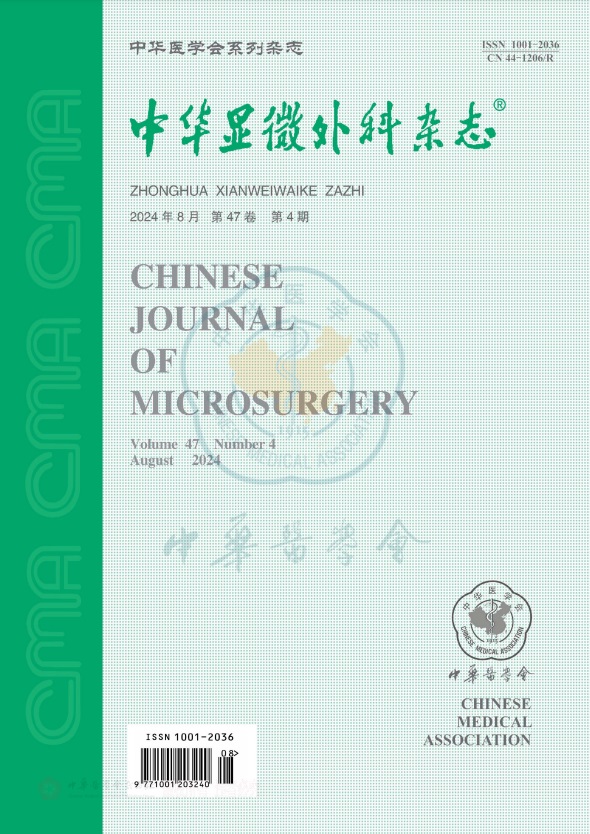隐神经支内胫后动脉穿支皮瓣在感觉重建中的临床应用
引用次数: 0
摘要
目的探讨隐神经支内胫后动脉穿支皮瓣用于感觉重建的手术方法和临床效果。方法自2016年1月至2018年6月,采用含隐神经支的胫后动脉穿支皮瓣治疗9例软组织缺损患者。男性7例,女性2例,年龄31~62岁。手部软组织缺损5例,足底2例,脚踝1例,足背1例。软组织缺损大小为8.0cm×2.5cm~21.0cm×4.0cm,术后定期随访。结果皮瓣全部成活,无并发症。皮瓣大小为10.0cm×3.5cm~230cm×5.0cm,供区一期闭合5例,二期闭合4例。随访6~15个月,平均10个月。皮瓣外形满意,供区感觉功能正常。随访6个月时,所有皮瓣的SW测试均达到5.07,2PD范围为14至35mm。结论新型感觉皮瓣在不牺牲大动脉和隐神经的情况下,能提供满意的感觉结果,是软组织缺损感觉重建的良好候选者。关键词:胫后动脉;穿孔皮瓣;隐神经;感觉重建;软组织缺损本文章由计算机程序翻译,如有差异,请以英文原文为准。
Clinical application of posterior tibial artery perforator flap within saphenous nerve branch for sensory reconstruction
Objective
To explore the operative technique and clinical results of posterior tibial artery perforator flap within saphenous nerve branch for sensory reconstruction.
Methods
From January, 2016 to June, 2018, 9 patients suffered from soft tissue defect were treated by the posterior tibial artery perforator flap containing saphenous nerve branch. Seven patients were males and 2 were females, with age ranged from 31 to 62 years. Soft tissue defects located in hands in 5 patients, plantar in 2 patients, ankle in 1 patient and dorsal foot in 1 patient. The size of soft tissue defects ranged from 8.0 cm×2.5 cm to 21.0 cm×4.0 cm. The regular post-operative followed-up was performed.
Results
All flaps survived without complications. The size of flap ranged from 10.0 cm×3.5 cm-23.0 cm×5.0 cm. Donor sites were primarily closed in 5 patients and secondary closed in 4 patients. Followed-up ranged from 6 to 15 months with 10 months in average. The contour of flaps were satisfied and the sensory function of the donor sites were normal. At 6 months followed-up, SW test reached 5.07 in all flaps, and 2PD ranged from 14 to 35 mm.
Conclusion
The novel sensory flap can provide satisfied sensory outcome without sacrificing main artery and saphenous nerve, and is a good candidate for sensory reconstruction of soft tissue defects.
Key words:
Posterior tibial artery; Perforator flap; Saphenous nerve; Sensory reconstruction; Soft tissue defect
求助全文
通过发布文献求助,成功后即可免费获取论文全文。
去求助
来源期刊
CiteScore
0.50
自引率
0.00%
发文量
6448
期刊介绍:
Chinese Journal of Microsurgery was established in 1978, the predecessor of which is Microsurgery. Chinese Journal of Microsurgery is now indexed by WPRIM, CNKI, Wanfang Data, CSCD, etc. The impact factor of the journal is 1.731 in 2017, ranking the third among all journal of comprehensive surgery.
The journal covers clinical and basic studies in field of microsurgery. Articles with clinical interest and implications will be given preference.

 求助内容:
求助内容: 应助结果提醒方式:
应助结果提醒方式:


